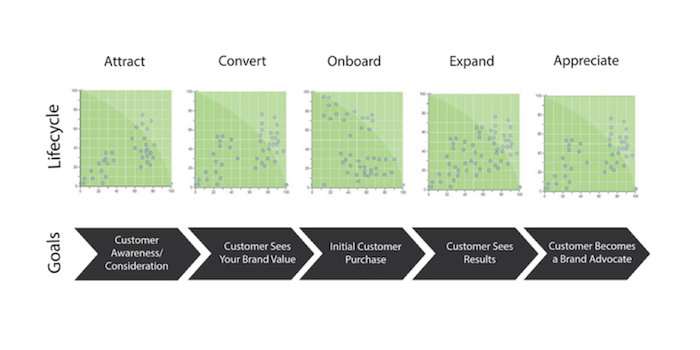Is customer lifecycle marketing effective? Does it make good financial sense to pursue? In this article, discover the essential benefits of managing relationships throughout each stage of the customer lifecycle.
Relationships are complicated, and each one of them is as unique as the people who are involved in them. When it comes to the relationships between your company and its customers, it’s useful to think of this complex process in terms of a lifecycle.
In your overall CRM strategy, this means acknowledging and adapting to the unique needs of each relationship. It flows from the point of first contact, through qualifying leads, and extends way beyond the point where a sale is made.
Customer Lifecycle Marketing makes good financial sense
In terms of your marketing ROI, generating revenue from existing clients is more cost effective than finding new customers. The goal is repeat business from loyal buyers – who end up becoming evangelists for your brand, eventually.
Building and maintaining relationships throughout the customer journey is a winning formula for engaging and retaining happy customers. That’s where the concept of Customer Lifecycle Marketing shines. What is ‘lifecycle marketing’, exactly?
Sterne and Cutler, defined the concept of the customer lifecycle back in 2000. They broke down the different stages of the typical customer lifecycle this way:
1) Claim someone’s attention,
2) Bring them into your sphere of influence,
3) Turn them into a registered and/or paying customer,
4) Retain them as a customer,
5) Turn them into a company advocate.
You could simplify that even more, and say the lifecycle has only three stages: Attract, sell, and “wow.”
What this means in practical terms is that you always need to know at what stage of the cycle your customer is, and then tailor your marketing communication, accordingly.
For example, if a potential customer knows nothing about your company and is at the early stage of the sales cycle, the first step is obviously to grab his attention, and show him why it’s worthwhile finding out about you.
Then, based on the automation rules you have created (depending on what he clicks on or downloads, for example), he moves to the next stage of the lifecycle – nurturing. As the client progresses, key touch-points trigger new messages and ways to interact.
An introductory message would be lost on someone who is already a repeat client, or someone who opts out of the sales loop.
Here your messages and your tactics would be geared towards retention, up-selling, reminding, and encouraging the customer to share that message on social media – which are all further along in the cycle.
At a later stage of the journey you might want to inform a sales rep to follow up. Smart digital marketing software pinpoints where your client is in the cycle, and adapts to suit his needs, no matter which channel the trigger comes from.
In order to make it work, you’ll have to consider your buyer’s journey in its entirety, and then set up different stages that make sense in your business. From there you can customize your triggers, responses and automated actions. If you’re not paying attention to where your customers are in their sales cycle, you may be leaving money on the table.

